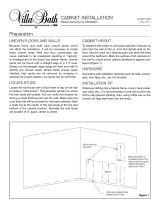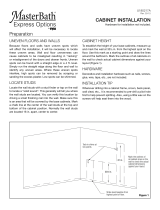
EXTERIOR CARE AND CLEANING
For normal spills, a damp cloth is sufficient. Remember to
dry the surface immediately. Lemon oil is recommended
for cleaning wood doors. Most furniture care products, not
containing wax, petroleum solvents or silicone can be used
for polishing. Do not use caustic agents and/or abrasive
scrubbers. Nicks and dings can be repaired using the
color sticks. Fill in the scratch or nick using the color stick.
A Clear Coat spray may be applied if desired.
INTERIOR CARE AND CLEANING
Cabinets can be cleaned with a damp sponge or cloth
using soapy water. Do not use any type of abrasive
scrubbers. Do not let liquids stay on the surfaces for a long
period of time. The surface is water resistant, not waterproof.
MIRRORS
Use a water-dampened cloth to clean the mirror frame. For
the mirror, use ammonia-free cleaning products. Avoid using
abrasive cleaners.
Customer Service and Parts Department
Voice: (800) 221-3051 • Fax: (714) 449-2208
RSI HOME PRODUCTS, INC. LIMITED WARRANTY
Care and Cleaning
What This Warranty Covers: RSI Home Products, Inc. (“RSI”)
warrants its parts and products to be free of substantial defects
in materials and workmanship from the original date of purchase
under normal home use. This warranty is offered only to the
original consumer purchaser and may not be transferred.
How Long The Warranty Lasts: Coverage for all vanity
cabinets, fixed vanities, drawer banks, bath storage cabinets,
linen cabinets, wall hutches, fillers, and toe kicks last for the life
of the product. Coverage for medicine cabinets, mirrors, and
accessories lasts for 5 years from the original date of purchase.
What RSI Home Products Will Do Under The Warranty:
During the warranty period, RSI, at it’s option, will repair or replace
any part or product that proves to have substantial defects in
materials or workmanship, or RSI will provide an equivalent
replacement product. In keeping with our policy of continuous
product improvement, RSI reserves the right to change
specifications in design and materials without notice and with no
obligation to retrofit products we previously manufactured.
How State Law Applies: This warranty gives you specific legal
rights, and you may also have other rights that vary from state
to state.
IMPLIED WARRANTIES: RSI DISCLAIMS ANY IMPLIED
WARRANTY OF MERCHANTABILITY, AND THERE ARE NO
WARRANTIES THAT EXTEND BEYOND THE DESCRIPTIONS ON
THE FACE HEREOF. TO THE EXTENT THAT SUCH DISCLAIMER
IS NOT VALID UNDER APPLICABLE LAW, ANY IMPLIED
WARRANTY SHALL BE COEXTENSIVE IN DURATION WITH THIS
WARRANTY.
Wood, Aging and Printing Limitations: Because of the varying
natural characteristics of wood and the effects of aging, product
shown in displays and/or printed materials will not be an exact
match to new cabinetry you will receive. Depending on the wood
characteristics, the age of the sample and the environment
of the showroom, samples will show some degree of variation
from new product. In addition, you should not expect all doors,
drawer fronts, trim or moulding to match exactly in either finish
or grain. Variation in wood is normal and unavoidable. In addition,
it is not possible to exactly match our colors in printed materials.
Therefore, you should view the actual samples when making your
color selection.
What This Warranty Does Not Cover: This warranty does
not cover any problems or damage which result from improper
transportation, improper installation, mishandling, misuse, abuse,
neglect, abnormal use, commercial use, improper maintenance,
non-RSI repairs, accidents, or acts of God, such as hurricanes,
fire, earthquakes or floods. This warranty and any applicable
implied warranties do not cover incidental or consequential
damages arising from any defects in the product, such as
labor charges for installation or removal of the product or any
associated products. This warranty does not cover defects or
damages caused by normal wear & tear, alterations, environmental
conditions, humidity absorption, or mold. In addition, variations in
wood grain, finish color, aging or other natural wood and stain
characteristics are not considered defects and are not covered by
this warranty. Some states do not allow the exclusion or limitation
of incidental or consequential damages, so the above limitation or
exclusion may not apply to you.
How To Obtain Warranty Services: If you need replacement
parts or would like to make warranty claim, please contact our
Customer Service Representative by mail, e-mail, fax, or telephone
at the address or phone numbers listed on this page. All warranty
claims must include the model number of the product, copy of
the original receipt and the nature of the problem. In addition,
RSI may at its discretion require inspection of the installation
site or authorize the prepaid return of the claimed defective part.
Merchandise not pre-approved for return will not be accepted and
the associated claim not accepted.
If upon inspection you find our product has a damaged or missing
part, it may not be necessary to return the unit to the store of
purchase. Please contact RSI Customer Service to obtain a
replacement part.












